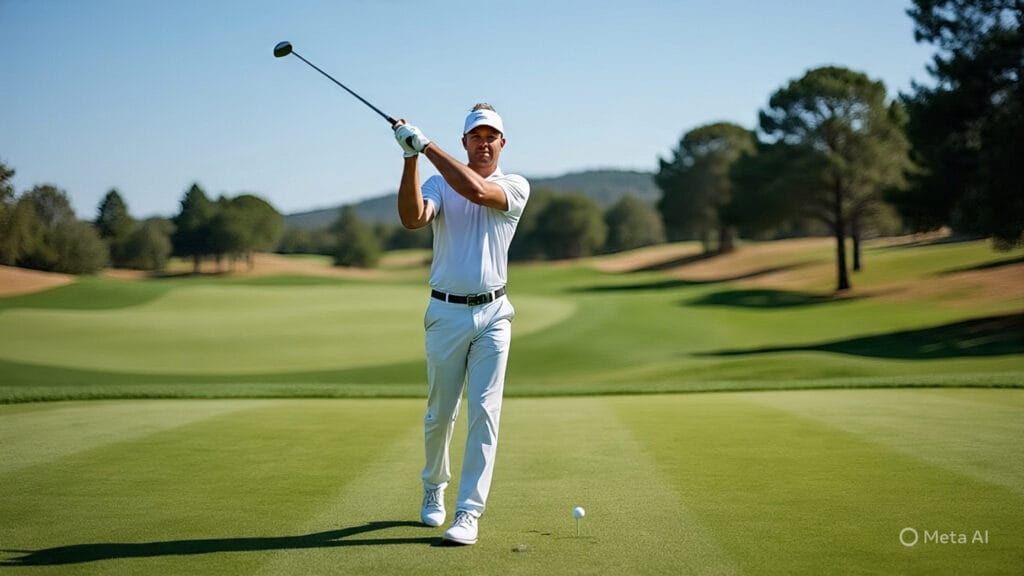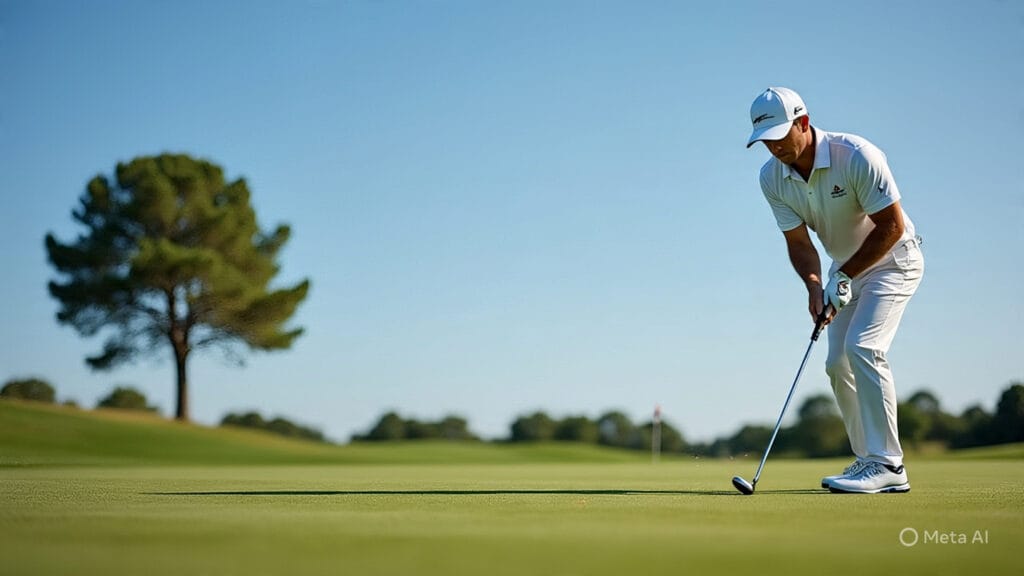Top Takeaways and Key Concepts
Please Note: This post may contain affiliate links. If you click one of them, we may receive a commission at no extra cost to you. As an Amazon Associate, I earn from qualifying purchases.
→ Master your grip technique to improve control, balance, and consistent power on every swing.
→ Maintain proper posture by bending at the hips, keeping your back straight, and knees slightly flexed.
→ Develop swing rhythm through steady practice and smooth, connected motion across your full swing.
→ Refine your short game with accurate chips and proper weight balance on each shot.
→ Perfect your putting by focusing on grip pressure, alignment, and a controlled follow-through.
Summary of This Article
This article breaks down the essential building blocks of great golf—grip, posture, swing rhythm, and short game mastery. By fine-tuning these fundamentals, players gain smoother motion, more accurate shots, and greater confidence on the greens. It’s all about steady practice, balance, and enjoying every moment of improvement on the course.
Video Summary
Golf is one of those sports that can make you feel like a superstar one minute and a complete klutz the next. Ever hit a hole-in-one? Yeah, me neither! But let’s dive into some golf tips that could help you go from “whoops” to “wow!” Whether you're just starting or have been playing longer than you've had your favorite pair of socks, there’s always room to improve. So, grab your clubs, and let’s tee off!
Understanding Your Grip – The Foundation of Your Swing

Let's get into something very important: grip! Have you ever seen someone swing their club like they're trying to hit a fly? It can appear really dumb! The first step to playing well is to have a decent grip. It makes everything in your game work out well.
Don't hold the club with your hands. Hold it with your fingers. It may sound funny, but it makes a tremendous impact! Using your fingertips gives you more control over the clubhead as you swing. You have to feel comfy but firm when you hold on to a juicy burger, right? But don't panic; we want less mess!
Don't squeeze too hard! Imagine cradling a baby bird. You could harm it or lose control totally if you grip it too tightly. Find the right balance between a firm and relaxing grip. That's where the magic happens.
You need to practice and take your time to get it perfect. Spend some time at the driving range just working on how you hold the club. It might seem monotonous at first, like watching paint dry, but trust me, it will be worth it! Once you get the grip right, you'll be able to hit those drives down the fairway like a pro.
Getting used to your grip will make you appreciate golf even more. You will feel better about yourself and have fun as you play. Don't rush yourself; every little step matters in getting stronger. Keep practicing.
Think about how you're gripping that club the next time you're out there swinging away. You'll have a great day on the course if you have a good grip. Have fun every second you're out there!
Posture Perfection – Stand Tall and Swing Right

Now that we've got our grips set, let's talk about how to stand. You know what I mean if you've ever seen someone who appears like they're ready to fall over while trying to whack a ball. Good posture helps you stay balanced during your swing and can keep you from getting hurt (since no one wants to be limping about after a round of golf).
To begin, stand with your feet shoulder-width apart and picture yourself as a tree securely planted in the ground. You can't have a hunchback here, so bend your hips a little bit while maintaining your back straight. Your knees should be slightly bent so that you're ready to go.
It's also very important where you put the ball. For drivers and woods, put it close to your front foot. For irons or wedges? Moving toward the center of your posture works wonders. You might have to try a few times to get this right, but hey, Rome wasn't built in a day!
In the end, having strong posture isn't just about looking beautiful (though that helps); it's about getting ready to succeed every time you take a shot.
The Swing—Timing is Key

Yes, the moment we've all been waiting for: the swing itself! If we could only put all those flawless swings we watch on TV in a bottle and take them out whenever we needed them… Sadly, that's not how life works!
When you get ready to swing, rhythm comes into play. You don't want it to be rushed like you're late for dinner or dragged out like an embarrassing family gathering. Find that groove where everything works together perfectly.
When you start your backswing, which is when you pull back, make sure your arms and body stay connected. Think of them as best friends who work together instead of distant relatives who only see each other on holidays.
And then there's impact, which is where the magic happens! Instead than just striking the ball, try to hit through it. Imagine yourself breaking through an imaginary wall behind it. That's how to get power without losing precision!
Lastly, and I can't say this enough, you have to practice to get better! It may seem boring to hit bucket after bucket at the range, but trust me, you'll soon be able to dazzle everyone with those gorgeous arcs flying across the sunny sky.
Secrets for the Short Game: How to Chip Like a Pro

Now let's change the subject and talk about chipping, which is just as vital. People typically forget this element since who doesn't like long drives? But if you're caught in tough terrain or near bunkers, it becomes quite important!
The secret is to use smaller swings that are more accurate instead of going full speed every time. Think about finesse instead of strength. After all, no one wants their ball to go past the green faster than they can make par!
When hitting short chips around greens, keep two things in mind: lean forward a little and retain your weight on your front foot. This will help you make strong contact with as few mistakes as possible.
Next, you need to pick the right club based on how far you need to hit it. You can use pitching wedges, sand wedges, or any other club that will give you the right amount of lift-off the ground before landing softly on the putting surface below.
So try these ideas the next time you have to hit a tough chip shot. They might help you save a few strokes that you don't want to tell embarrassing stories about later at the clubhouse bar.
Putting Skills—Sink Those Birdies

Putting is the aspect of golf that can make you feel like a wizard or a total idiot. One minute you're making a great birdie putt, and the next you're missing three putts from five feet away. It makes you reconsider everything you've ever done! But don't worry; I'm here to give you some great putting tips that will hopefully help you change your game from “oops” to “wow!” So, get your putter and let's go!
Getting to Know the Basics of Putting
Let's go back to the beginning to start. You're not the only one who has ever questioned why those little holes are so minuscule. Knowing what goes into putting is the key to doing it well.
First of all, your stance is important! To keep your equilibrium, stand with your feet shoulder-width apart. You want to be calm and stable at the same time. Think of standing like a flamingo wanting to impress its friends—confident but not too stiff. To stay grounded, bend your hips a little and maintain your knees supple.
Next, there is alignment. How many times have we aimed at one location only to have the ball go off course like it had a mind of its own? Put your body in line with the target line, which is an imagined straight line that goes straight to the hole. Your shoulders should do the same thing. If they're all goofy, good luck getting the ball anywhere near where it needs to go!
Last but not least, let's talk about grip pressure. It's really important! Too tight? You might as well be trying to get toothpaste out of a tube that is already empty. Is it too loose? Well, let's just say that ball will go in directions you didn't expect.
How to Read Greens Like a Pro
Now it's time for one of my favorite things: reading greens! This is when you need to be like Sherlock Holmes and figure out what those sly slopes and bumps are doing to your ball.
Before you putt, take a time to look at the green as if you were sizing up a chess opponent (or maybe just thinking about whether or not they'll share their snacks). Look for any hills or valleys that could change how fast or slow the ball rolls. Even a small slope can make a big difference, as you'll see.
It's interesting that the type of grass also matters; differing types can have a big effect on speed. Bermuda grass, for instance, grows thicker than bentgrass, which implies that Bermuda greens roll more slowly than smooth greens.
And speaking of speed, don't forget to think about pace when you read! You'll need different amounts of power behind each stroke if you're hitting shots up, down, or even sideways. It's like deciding how hard to toss candy at someone on Halloween: it depends on how far away they are and how windy it is!
The Perfect Stroke: Getting Better at Consistency
Okay, let's get started on making the perfect putting stroke. Every golfer wants to be able to do it without looking like they're doing interpretive dance moves on the course.
Instead of wildly jabbing at the ball, start by focusing on making smooth backswings (unless you're trying to be funny). Moving in a controlled way feels more natural and makes you more accurate overall, like dancing without treading on toes!
It's also important how long your backswing is. Think of Goldilocks: not too long, not too short, but just perfect! A shorter swing usually gives you better control over distance, while lengthier strokes can make things less consistent (and who wants that?).
What about follow-through? It's important because it helps keep you on track after you hit something, like delivering high-fives instead of uncomfortable fist bumps after sinking a putt! As if you're reaching for something truly good just out of grasp, aim for an extension toward your target line.
Getting Better at Putting
Last but not least, it's time to practice! But don't worry, I'm not saying you should spend hours crouched over exercises unless that's what makes you happy (hey, we all have our own weird things).
Instead of focusing on quantity, focus on quality. put particular goals for your practice sessions, such hitting targets put up in different spots around greenside bunkers or fringes around holes. This will make it more exciting and provide you chances to develop.
You might also add games to your routines. For example, you could challenge your pals to see who can sink consecutive putts from the same distance, or you could make tournaments with different hole placements on the courses you visit together.
But all things considered, the more time you spend working on your talents, the better you'll do on tournament day… even if it means giving up valuable hours of couch potato time to binge-watch TV instead!
Featured Snippet: Improving your golf game starts with mastering the basics—grip, posture, swing rhythm, and short game control. By practicing consistently, keeping balanced posture, and focusing on smooth, accurate strokes, golfers can boost performance, confidence, and enjoyment on every round.
Frequently Asked Questions
Why is grip technique so important in golf?
Your grip controls the clubface and impacts both accuracy and power. A balanced, finger-based grip provides better feel and consistency throughout your swing.
How can I improve my golf posture?
Stand tall with feet shoulder-width apart, bend at the hips, and keep your back straight. This ensures balance and prevents strain during swings.
What’s the best way to develop swing rhythm?
Focus on smooth, connected motion rather than speed. Consistent rhythm builds muscle memory and helps generate power without losing control.
How do I practice chipping effectively?
Lean slightly forward with your weight on the front foot. Use controlled, short swings for precision instead of force for better accuracy.
Why do golfers struggle with putting consistency?
Common issues include poor alignment, uneven grip pressure, and rushed tempo. Maintaining a light, steady touch and smooth follow-through improves results.
How can I read greens more accurately?
Study the slope, elevation, and grass direction before putting. These details influence ball speed and path more than most players realize.
How often should I practice golf fundamentals?
Frequent, focused practice—just a few minutes daily—builds consistency faster than occasional long sessions at the range.
Suggested Resources
The Complete Golf Manual
https://www.golf.com/golf-tips/2023/01/10/the-complete-golf-manual/
Golf Digest's Best Tips
https://www.golfdigest.com/story/best-golf-tips-of-all-time
How To Improve Your Golf Game
https://www.pga.com/news/golf-tips/improve-your-game-with-these-simple-tips
Putting Tips for Beginners
https://www.pga.com/putting-tips-for-beginners
The Science Behind Putting
https://www.golf.com/instruction/the-science-behind-putting

Kevin Collier is an avid golfer and contributing author at AIGolfTips.com, where he shares his passion for the game through expert tips, techniques, and gear reviews. With years of experience on the course, Kevin offers valuable insights for golfers of all skill levels, helping them improve their game and maximize their potential. Whether discussing swing mechanics or the latest in golf technology, Kevin's engaging approach aims to inspire and educate fellow golf enthusiasts to elevate their performance and enjoy every moment on the green.





